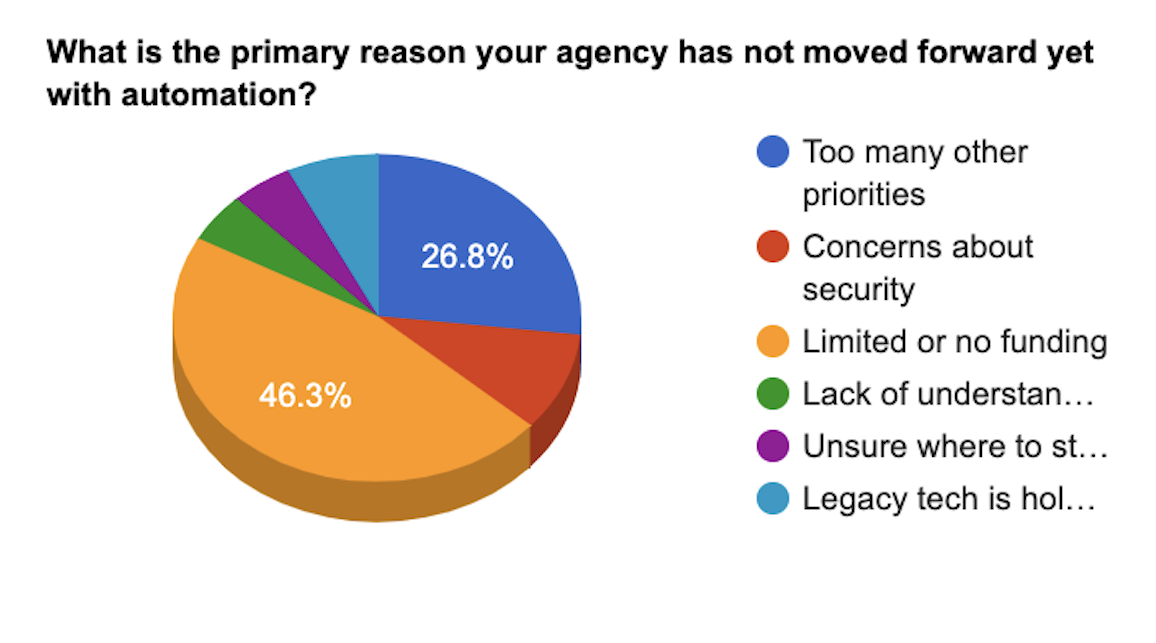Federal agencies are experiencing pandemic-level budget cuts and furloughs, such as the U.S. Citizenship and Immigration Services which is on track to furlough 70% of its workforce next month. Among trials of funding slashes, revenue shortfalls and furloughs, civil servants fear that automation might take their jobs too.
“I don’t think it’s a big secret that government is under some big budget cuts and scrutiny,” said Jennifer Hill, Program Analyst at the Treasury Department’s Bureau of the Fiscal Service.
“Who feels it the most? Our frontline workers. Our employees are desperate to have more time,” Hill said at GovLoop’s online training Thursday.

Poll results from GovLoop’s online training, “The Future of Customer Experience Is Automation” (July 9, 2020)
Civil servants are trying to deliver the services that people need with no time to waste.
For the past year and a half, those at the Fiscal Service saw some of their time handed back to them through robotic process automation (RPA), a type of artificial intelligence (AI) that automates repetitive functions. It was a good start for the agency to dip its toe in AI technologies. The agency is now looking to adopt more sophisticated AI capabilities, such as chatbots.
Civil servants at the Fiscal Service’s 20-plus contact centers take millions of calls, and oftentimes, they’re misdirected. That is, 75% of calls are directed to the wrong person or team, Hill said. Chatbots can take care of the misdirection through AI and deflect simple inquiries so employees can channel their energy into complex issues that require human empathy and mediation.
The agency is still in the beginning phases of exploring chatbots, but what the team has learned so far is clear.
“If we’re really going to make these technologies successful, first we’re going to have to operate more as an enterprise, not in silos. … And then, we really need to engage our IT shop. They have to be a key stakeholder, and not just from a technology viewpoint but a security perspective as well,” Hill said.
Starting with RPA was key in the success to shifting to a holistic and un-siloed perspective on AI. When RPA efforts first began, employees expressed hesitation and fear about being replaced. To alleviate these concerns, Hill said the agency engaged employees early on in the journey to decide the right use cases for the technology to be implemented. And then, there was a complete turnaround. Employees witnessed the efficiencies it brought and started to get excited.
“Now as we start talking about other technologies, that fear just isn’t there anymore,” Hill said.
Employees at the call centers know better than anyone the pain that customers feel. So from a customer’s perspective too, employees welcome the benefits AI can bring, Hill said.
In a poll at the online training, attendees were asked the primary reasons why their agency had not yet moved forward with automation and AI (see above). The majority, 46%, said it was due to limited or no funding. The next highest percentage said it was because there were too many other priorities, and the third highest percentage said it was due to security concerns.
Interestingly, in a research brief conducted by GovLoop and Genesys, a CX platform provider, the same question was surveyed to a government audience and the same three concerns were the top three. In the survey, the highest was competing priorities, second was security and third was funding.
To assuage each concern, Jodi Thompson, Senior Principal Business Consultant at Genesys, offered resolutions:
- Competing priorities: For agencies that do no prioritize AI, focus on the agency mission. Find tangible and measurable ways to show the business case for automation and how it aligns to your mission.
- Security: Choose a solution that is approved by the Federal Risk and Authorization Management Program (FedRAMP). This provides agencies a reliably standard level of security assurance.
- Limited funding: Start strategically and start small. You don’t need to program AI to do everything. Also, make sure you invest in solutions that are not static but will continue to grow as you grow. That makes your funding go a long way.
This online training was brought to you by:






Leave a Reply
You must be logged in to post a comment.